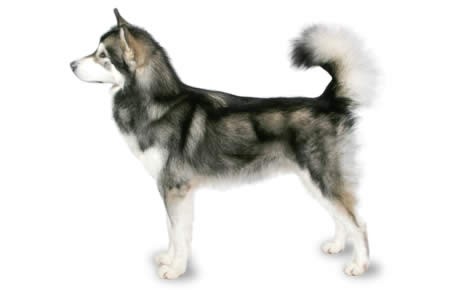Alaskan Malamute Breed Guide

Breed Group:
Working Dogs
Get 30% off
Join our Newsletter
Sign Up Today
Alaskan Malamute Breed Info & Background
Originally from the cold Alaskan regions, the Alaskan Malamute breed worked as an arctic sled dog that assisted Eskimos in their daily tasks. From hunting seals to pulling sleds, these powerful animals were praised for their strength and obedience.
Today, these household pets thrive in colder climates and love any kind of outdoor activities. This majestic breed is characterized by their wild wolf-like appearance, showcasing a thick coat and impressive stature.
Alaskan Malamute Temperament & Personality
The Alaskan Malamute showcases high loyalty to their owners. While they may not be the best watch dogs, they do love human interaction, attention, and companionship. On the downside, they can have a stubborn and strong-willed personality, making them a hard breed to train.
Is your family active and love to get outside? If so, the Alaskan Malamute is the dog for you. They love exploring and being outdoors whenever possible. When trained early on, these dogs can make a great addition to any active family.
Alaskan Malamute Training Tips
This breed can be quite difficult to train. They quickly become bored or uninterested if they do not want to participate in a certain activity. It is recommended to use firm and persistent training in order to turn an Alaskan Malamute into a well-behaved pet. Starting daily training while they are still a puppy will also increase the chances of success.
Exercise Requirements for Alaskan Malamutes
This working breed needs plenty of daily exercise. The Alaskan Malamute loves an active lifestyle. Whether it be running, swimming, or fetching, any outdoor activity is recommended for this rambunctious dog. An hour a day of walking or physical activity is recommended to keep their physical and mental state at its best. These dogs need plenty of activities to do throughout the day, or else they may become restless and demonstrate destructive behavior.
Alaskan Malamute Lifespan and Longevity
The average Alaskan Malamute lifespan is around 10-12 years. Since it is a large dog, the Alaskan Malamute life expectancy is shorter compared to small breeds.
Is the Alaskan Malamute a Popular Breed?
Currently, the Alaskan Malamute breed is the 59th most popular dog breed in America today. Many pet owners are drawn to this breed due to their wolf-like appearance and friendly nature.
Feeding Requirements for Alaskan Malamutes
Unlike many dogs their size, the Alaskan Malamute only needs about 3-4 cups of food a day. How much food they require is dependent on their size, age, and activity level.
Speak with your veterinarian to find a feeding regimen that is specifically created for your unique dog. Since these dogs have a tendency to overheat due to their thick coat, make sure water is readily available at all times.
Grooming Recommendations for Alaskan Malamutes
For optimal health, an Alaskan Malamute’s coat should be brushed on a regular basis. Their thick fur sheds twice a year and can be quite excessive if it is not combed regularly. A pin brush or metal-toothed comb are recommended for this type of fur. These brushes are able to reach the undercoat and rid any excess fur.
Regular brushing should lessen the seasonal shedding. When visiting the groomers, be sure to have their nails trimmed and ears checked as often as possible.
Are Alaskan Malamutes Good With Children?
These playful dogs can be great with kids if they have been properly trained from a young age. They are known to have a calm and loving temperament around children, especially if they are surrounded by constant human interaction. It’s still important to note that some Alaskan Malamutes become cautious around new children and should be closely supervised.
Alaskan Malamute Health Problems
- Hip dysplasia: This genetic deformity that causes abnormalities within the hip socket which can cause lameness, pain, or even arthritis. Hip dysplasia is common for larger dogs and is reported in roughly 12% of Alaskan Malamutes.
- Chondrodysplasia: Although uncommon, Malamutes carry a hereditary form of dwarfism called chondrodysplasia with stomatocytosis. This bone abnormality can cause deformities which results in a crooked or shortened stance.
- Hypothyroidism: This health issue occurs when there is an imbalance in the thyroid hormones being produced. Hypothyroidism can be easily cured through synthetic hormone pills.
- Cataracts: A type of cataract that appears at a young age is seen in about 8% of the breed. Fortunately, it rarely leads to blindness.
- Persistent pupillary membrane: Persistent pupillary membrane, in which a strand of embryonic tissue reaches from one side of the pupil to the other, is seen in 8% of Malamutes. It seldom affects vision.
- Polyneuropathy: This disease is a nervous system disorder that causes weakness and instability in dogs. Other symptoms include lack of coordination and hindlimb muscle atrophy.
- Zinc-responsive dermatosis: A deficiency in Zinc can cause hair loss and can even turn the skin red and crusted, especially on the head. A Zinc supplementation can reverse these side effects and help the skin go back to normal.
- Alopecia-X: Commonly referred to as black skin disease, Alopecia-X causes hair loss and the skin to blacken. This disease is caused by a growth hormone deficiency, which then results in a hyperpigmentation of the skin.
Other Resources
National Breed Website: Alaskan Malamute Club of America, Inc.
Rescues: Moonsong Malamute Rescue
Health Issues Associated with this Breed:
- Alopecia
- Cancer
- Cataracts
- Chondrodysplasia
- Epilepsy
- Hemeralopia (Day Blindness)
- Hip Dysplasia
- Hypothyroidism
- Inflammation
- Inherited Polyneuropathy
- Osteochondromatosis
- Pain
- Seizures





